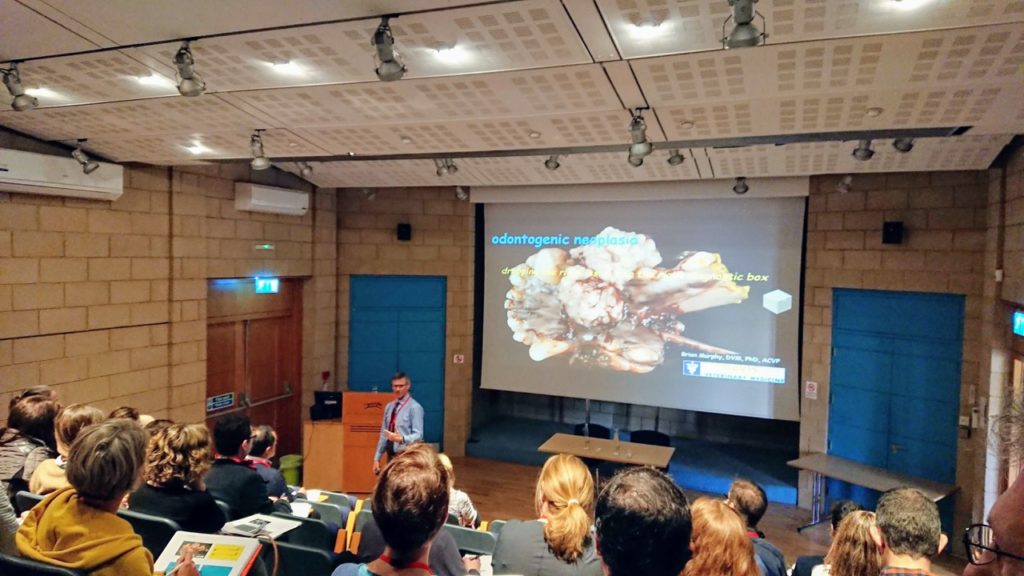Review of the British Society of Veterinary Pathologists Annual Meeting 2019 Oral and Maxillofacial Pathology at the British Racing School in Newmarket, Friday 18th – Saturday 19th October 2019.
I attended this meeting with anticipation of the learning to come, having wrestled with oral pathology for my specialism exams and found that I still didn’t know my stellate reticulum from my dental papilla. Oral masses are a common presentation in small animal and equine diagnostic pathology. I was excited to attend a meeting directly relevant to my routine diagnostic practice and to gain knowledge that could immediately benefit my patients. The keynote speaker of the meeting was Dr Brain G Murphy from University of California, Davis, a specialist in oral and orthopaedic pathology and co-author of the book Veterinary Oral and Maxillofacial Pathology. Dr Murphy spoke on several topics, covering proliferative and inflammatory lesions. Through his time at the lectern he instilled in the audience his passion for this somewhat intimidating area of pathology.
The primary learning point that I identified from Dr Murphy’s talks was that many oral tumours, both odontogenic and non-odontogenic, exist on a histological continuum. An example of this being the transition in histological features between an oral squamous cell carcinoma to a canine acanthomatous ameloblastoma. By visualising this continuum, Dr Murphy introduced a new way to firstly accept, and secondly to deal with, potential histological overlap between entities. This overlap may have previously resulted in a diagnostic dilemma and the potential for an inaccurate diagnosis from applying an overly rigid classification system. By explaining his approach, Dr Murphy gave the audience a valuable tool for their future diagnostic practice.
An additional piece of odontogenic wisdom bestowed by Dr Murphy was that an understanding of tooth embryology is essential to interpret oral pathology. Five minutes of tooth embryology study is worth 30 minutes study of the end-product lesions out of context.
We were treated to talks from both sides of the scalpel, with presentations from equine, and small animal dental specialists, Drs. Rachel Perry and Tim Barnett. Drs Perry and Barnett emphasised the clinical presentations of oral lesions and the questions they want to be answered by histology. These talks served to remind the attendant pathologists to always consider the needs of the readers when writing reports. The talks were also filled with relevant clinical knowledge and I have already used my new knowledge of equine oral diastemas to give additional context to a biopsy taken adjacent to a diastema. A talk on dental radiography from Dr Gerhard Putter, taught us radiographic changes associated with common dental conditions. This learning has the potential to refine our diagnostic accuracy as we can correlate the histology with diagnostic imaging information from submitted samples.
Professor Keith Hunter provided the bipedal take on this topic, with an outline of the recent human WHO classification of diseases of the head and neck. He also bridged clinical science and basic science by discussing the role of molecular pathology as a tool to explore the pathogenesis and diagnosis of oral disease. The question and answer session revealed that similar challenges are present within human and veterinary pathology when attempting to apply appropriate nomenclature and that further collaboration may be useful in this regard.
Early career colleagues were represented and celebrated by a talk from anatomic pathology resident Dr Kevin O’Brien from the Royal Veterinary College. Dr O’Brien was the recipient for the travel bursary for the best resident abstract, and presented his project on canine gallbladder neuroendocrine carcinoma. Networking and old-friend catch-up time was abundant and it felt like every delegate made contacts across both pathology and dentistry fields, ready to inspire new collaborations in the future.
In summary the BSVP meeting in oral and maxillofacial pathology was an inclusive and cerebrally stimulating meeting. The meeting has provided me with learning opportunities, educational resources and inspiration to get my teeth stuck in to this fascinating area of pathology. The biannual BSVP meetings deliver CPD in veterinary pathology and aim to involve clinicians and pathologists working across all disciplines and species. Updates on future meetings can be found at www.bsvp.org.

